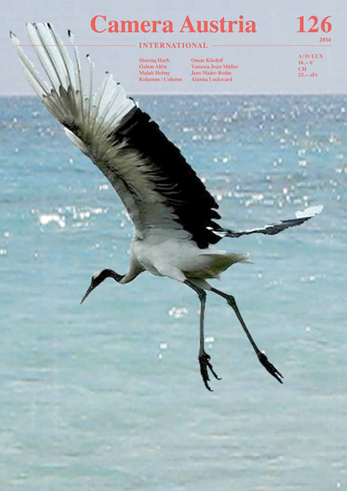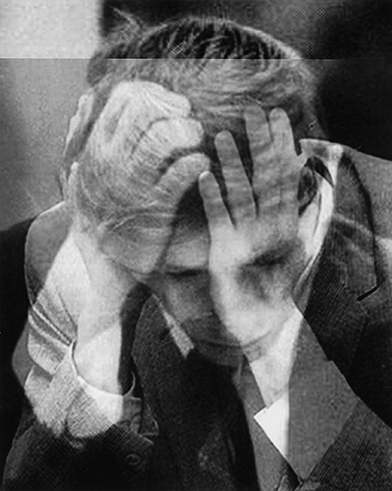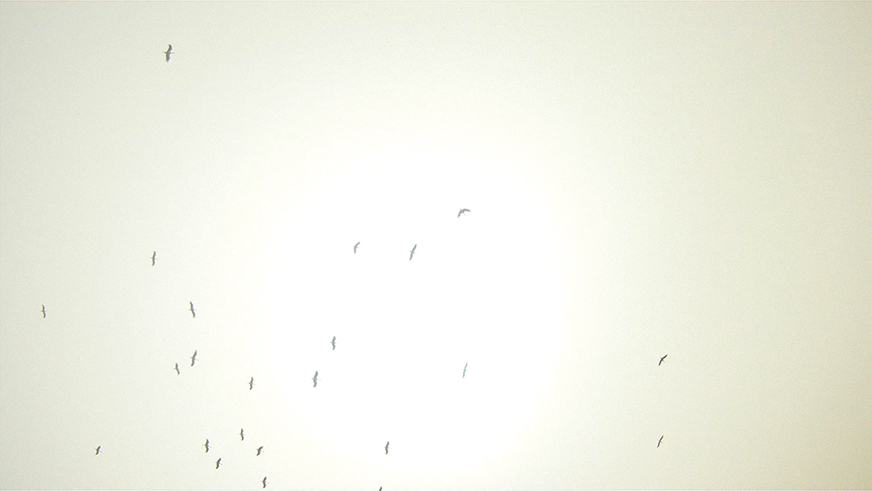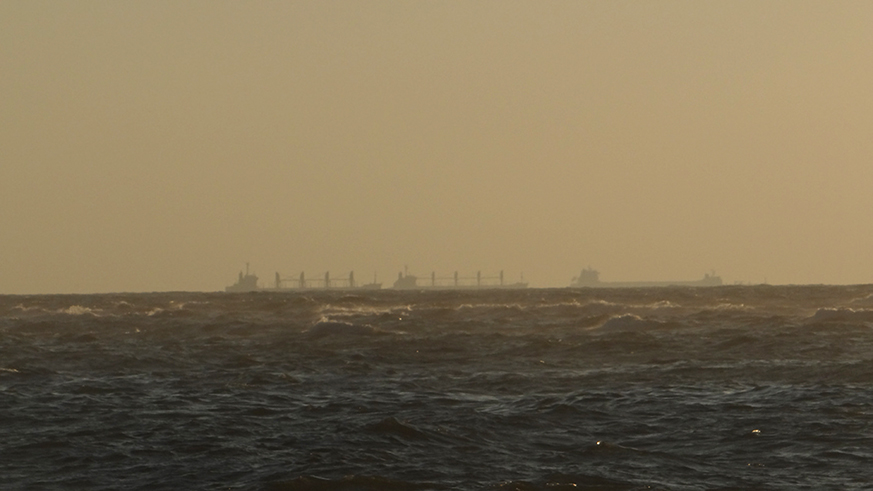Camera Austria International
126 | 2014
- OMAR KHOLEIF
Shuruq Harb: Negotiating Absence and Value - SURUQ HARB
The Keeper - VANESSA JOAN MÜLLER
Özlem Altin: The Gesture of Touching - Özlem Altin
- JENS MAIER-ROTHE
Malak Helmy: Of RareEarths and Isotopes - MALAK HELMY
- ALANNA LOCKWARD
Decolonising the (White) Gaze 2/4
Gordon Parks’s Whip and the “Unintended Liberating Dimension“ of Enslavement

Preface
The starting point for the current issue was initially summed up with the term “visual agency”. The increase in dissemination channels and the accompanying (at least potential) publicness of visual narratives has resulted in the fact that there is hardly any more control over the contexts in which images circulate and how they are perceived, interpreted, commented on, and exploited. In the (relatively new) mass media euphemistically called “social” networks, images in any case alternate unchecked between the registers of fiction, authenticity and fetish, between evidence and manipulation, criticism and affirmation, and pass through the most varied and contrasting contexts. Hito Steyerl already described this situation a few years ago with the term “poor image”: “The poor image is a copy in motion. Its quality is bad, its resolution substandard. As it accelerates, it deteriorates. It is a ghost of an image, a preview, a thumbnail, an errant idea, an itinerant image distributed for free, squeezed through slow digital connections, compressed, reproduced, ripped, remixed, as well as copied and pasted into other channels of distribution.” (“In Defense of the Poor Image”, 2009) Moreover, in this circulation, what is concerned is hardly ever solely a dispositif of images, although they are almost always framed by a rumour, a communication, by various channels of information and above all by narratives, comments and texts.
Read more →Camera Austria International 126 | 2014
Preface
The starting point for the current issue was initially summed up with the term “visual agency”. The increase in dissemination channels and the accompanying (at least potential) publicness of visual narratives has resulted in the fact that there is hardly any more control over the contexts in which images circulate and how they are perceived, interpreted, commented on, and exploited. In the (relatively new) mass media euphemistically called “social” networks, images in any case alternate unchecked between the registers of fiction, authenticity and fetish, between evidence and manipulation, criticism and affirmation, and pass through the most varied and contrasting contexts. Hito Steyerl already described this situation a few years ago with the term “poor image”: “The poor image is a copy in motion. Its quality is bad, its resolution substandard. As it accelerates, it deteriorates. It is a ghost of an image, a preview, a thumbnail, an errant idea, an itinerant image distributed for free, squeezed through slow digital connections, compressed, reproduced, ripped, remixed, as well as copied and pasted into other channels of distribution.” (“In Defense of the Poor Image”, 2009) Moreover, in this circulation, what is concerned is hardly ever solely a dispositif of images, although they are almost always framed by a rumour, a communication, by various channels of information and above all by narratives, comments and texts.
How do matters therefore stand with respect to the agency of images under these circumstances of the unshackling of the visual? What strategies do artists select to produce a specific context, to occupy the specific site of a visual assertion? How do they react to the routes of appropriation and reinterpretation to which the images lose their title and credits? Which images do not exist nevertheless; which have been neglected? What is still suppressed so that it cannot become visible? Such questions lead to an idea—of any type whatsoever—of a “site” of images that might be constructed and from which they can be read. Yet, just as what can be seen and what can be said are linked by the boundary that separates them, the contributions in this issue are connected to the idea of their conception in that they oppose or at least, however, shift it.
Shuruq Harb’s “The Keeper”—which was published in 2011 as a limited book edition—at the same time also comprises an installation and a performance and makes use of the archive of Mustafa, a street vendor in Ramallah, who prints out images from the Internet and sells them in boxes. In the past, Mustafa’s family still imported images, for instance, from China, Lebanon, or Syria. In 2010, Harb acquired some 2,000 of such unsold images and sifted through and arranged them together for “The Keeper”. This archive documents a changing access to images and a change in how they circulate. Many of these images were at times officially barely accessible or even banned, which is why the archive traces the history of image regimes—public as well as private—and thus represents a specific form of distribution of the sensible. In his text contribution, Omar Kholeif asks how the immaterial images of the present can still gain something like value. Shuruq Harb works through this insoluble riddle through collecting such images that have dropped out of the present and would very quickly become lost without her intervention.
The work of Özlem Altin is linked with that of Shuruq Harb by the work on or from an archive. Central motifs in her oeuvre are the human body and the codes that it emits. In this, Vanessa Joan Müller, however, finds a subtle moment of the uncanny in and between her images, in the sense of a relationship between the animate and the inanimate that has become blurred, between the body and its eidetic double, which has solidified into a nature morte. The frozen poses, mute gestures, and motionless individuals subject themselves to the discriminating gaze as objects and yet escape it again and again. What might seem to be a system of ordering can instead be described better through a type of stream of images and image layouts, an ongoing constructing and deconstructing of meanings, references and aesthetics. As Müller describes: “Here, equivocation on a semantic plane encounters an emphasis on the formal structure, on rhythm, timbre, that avoids obviousness while simultaneously uniting language and aesthetics.” The starting point for all of this is, however, a collection of the most diverse images from different sources which Altin links without any hierarchy of origin, also with reference to pictures that she has taken herself.
Malak Helmy’s contribution goes back to a cooperation on an exhibition between Camera Austria and Beirut last autumn. “Unexpected Encounters” focused on the translation errors in political and cultural transfer. Malak Helmy participated in this exhibition with a sound work that took the mimetic abilities of the lyrebird as its starting point for addressing questions of identity and subjectivity. In his text contribution, Jens Maier-Rothe also writes about birds, migratory birds and their navigation skills. They always follow the same routes, in which their flight also seems to be a surveying of historical space. The artist pursues these traces in Egypt, a land of change, in which channels of communication decay like the coordinates of everyday life. Malak Helmy again and again examines the structural and narrative cores of a fluid power and a fragile history in order to bring something to light that would otherwise possibly remain incomprehensible or concealed. Her works cast nets in which stories, memory, and present become entangled along a blurred border between fiction and reality.
Leipzig is surely one of the German cities from which some of the most important impetuses for the field of contemporary photography have developed in recent years. This significance is also reflected in our exhibitions and the magazine. The fact that Camera Austria International is this year’s media partner for the f/stop Festival für Fotografie Leipzig is based on a connection of many years with the “site” Leipzig. After many discussions about how this cooperation might be made visible in the magazine, we decided on an independent contribution from the festival that makes the particular approaches to the contemporary in photography readable. This contribution replaces the traditional Forum section in this issue.
The extensive network of authors, who continuously challenge us with their proposals, has once again resulted in a fascinating spectrum of reviews of current exhibitions and recently published books. We are pleased that it continues to be possible for us to offer this specific format of the magazine as a platform for these multifaceted contributions. Our gratitude goes to all who continue to hold firm to this format, whether our authors, subscribers, our advertising customers, or also our readers, wherever this issue might fall into their hands! Good opportunities for this are offered within the framework of our upcoming participation in fairs and festivals, e.g. in the f/stop Festival für Fotografie Leipzig, Art Basel and I Never Read, the Art Book Fair Basel, the Vienna Photobook Festival and the Rencontres d’Arles.
Reinhard Braun
and the Camera Austria Team
June 2014
Entries
Forum
f/stop Festival für Fotografie Leipzig
Get lucky!
Presented by Christin Krause & Thilo Scheffler
Hans Eijkelboom
Beni Bischof
Jana Schulz
Stephanie Kiwitt
Exhibitions
Mehdi Meddaci: Nous nous sommes levés
Centre Photographique d’Ile-de-France, Pontault-Combault
MICHÈLE COHEN-HADRIA
Anna Mendieta: Traces
Hayward Gallery Southbank Centre, London
Museum der Moderne, Salzburg
ULRIKE MATZER
James Benning: Decoding Fear
Kunsthaus Graz
Kunstverein in Hamburg
CHRISTIAN HÖLLER
Moyra Davey: Burn the Diaries
mumok, Wien
Institute of Contemporary Art, University of Pennsylvania, Philadelphia
MARGIT NEUHOLD
Georges Didi-Huberman and Arno Gisinger:
Nouvelles histoires de fantômes
Palais de Tokyo, Paris
ELLIE ARMON AZOULAY
Victor Burgin: Formen des Erzählens
Museum für Gegenwartskunst, Siegen
LILIAN HABERER
Candida Höfer: Düsseldorf
Stiftung Museum Kunstpalast, Düsseldorf
Landesgalerie Linz des Oberösterreichischen Landesmuseums
Kunstmuseum Luzern
CHRISTINA TÖPFER
Maryam Jafri: Mouthfeel
Gasworks, London
MARTIN HERBERT
Carrie Mae Weems: Three Decades of Photography and Video
Guggenheim Museum, New York
Cantor Arts Center at Stanford University, Stanford
Cleveland Museum of Art
Portland Art Museum
Frist Center for the Visual Arts, Nashville
NICOLAS LINNERT
Christopher Williams: The Production Line of Happiness
Art Institute of Chicago
MoMA, New York
Whitechapel Gallery, London
MARIO PFEIFER
Stephan Panhans: Too Much Change Is not Enough
Haus am Waldsee, Berlin
JENS ASTHOFF
Lisa Oppenheim: From Abigail to Jacob (Works 2004–2014)
Grazer Kunstverein, Graz
Kunstverein in Hamburg
FRAC Champagne-Ardenne, Reims
MAREN LÜBBKE-TIDOW
Andreas Fogarasi: Vasarely Go Home
Galerie für Zeitgenössische Kunst, Leipzig
Museum Haus Konstruktiv, Zürich
Trafó Gallery, Budapest
Museo Nacional Centro de Arte Reina Sofía, Madrid
REBECCA WILTON
As You Can See: Polish Art Today
Muzeum Sztuki Nowoczesnej, Warsaw
KRZYSZTOF PIJARSKI
Ute Mahler und Werner Mahler: Werkschau
Deichtorhallen Hamburg, Haus der Photographie
BRITTA PETERS
Schöne Neue BRD? Autorenfotografie der 1980er Jahre
Museum für Photographie, Braunschweig
CAROLIN FÖRSTER
Apartheid & After
Huis Marseille, Amsterdam
TACO HIDDE BAKKER
60. Internationale Kurzfilmtage Oberhausen:
Memories Can’t Wait – Film without Film
Oberhausen
RAINER BELLENBAUM
Books
THE REVOLVING BOOKSHELF
Monica Haller: Riley and his story. Me and my outrage. You and us
onestar press, Paris; Fälth & Hässler, Värnamo 2009
Geert van Kesteren: Bagdad Calling. Reports from Syria, Jordan and Iraq
episode publishers, Rotterdam 2008
Carolin Emcke: Von den Kriegen. Briefe an Freunde
Fischer Verlag, Frankfurt/Main 2004
JAN WENZEL
Stefan Römer und Renate Wiehager (Hg.):
The ups and downs of Stan Back
Textem Verlang, Hamburg; A-Musik, Köln 2013
ULRIKE GERHARDT
Diana Artus: In Visible Cities
Plan Bey, Beirut; Berlin Beirut Multiples, Berlin 2013
RAIMAR STANGE
Ryszard Wasko: Choice
Verlag der Buchhandlung Walther König, Köln 2014
SANDRA KRIZIC ROBAN
Imprint
Publisher: Reinhard Braun
Owner: Verein CAMERA AUSTRIA. Labor für Fotografie und Theorie.
Lendkai 1, 8020 Graz, Österreich
Editors: Margit Neuhold, Christina Töpfer, Rebecca Wilton.
Translators: Dawn Michelle d’Atri, John Doherty, Amy Klement, Ivana Ostojčić, Wilfried Prantner.
English proofreading: Dawn Michelle d’Atri
Acknowledgments: Özlem Altin, Jens Asthoff, Rainer Bellenbaum, Beni Bischof, Victor Burgin, Silvie Jo Buschmann, Regine Ehleiter, Hans Eijkelboom, Carolin Förster, Shuruq Harb, Markus Haslinger, Malak Helmy, Gabriele Hofer-Hagenauer, Candida Höfer, Omar Kholeif, Stephanie Kiwitt, Maria Magdalena Koehn, Christin Krause, Alanna Lockward, Jorge Lockward, Lotte Lyon, Jens Maier-Rothe, Step Morgan, Vanessa Joan Müller, Sabine Niewalda, Stefan Panhans, Annalena Schäfer, Thilo Scheffler, Dorothee Sorge, Jana Schulz, Jules Spinatsch, Raimar Stange, Robert Stürzl.
Copyright © 2014
All rights reserved. No parts of this magazine may be reproduced without publisher’s permission.
Camera Austria International does not assume any responsibility for submitted texts and original materials.
ISBN 978-3-902911-08-7
ISSN 1015 1915
GTIN 4 19 23106 1600 5 00126










